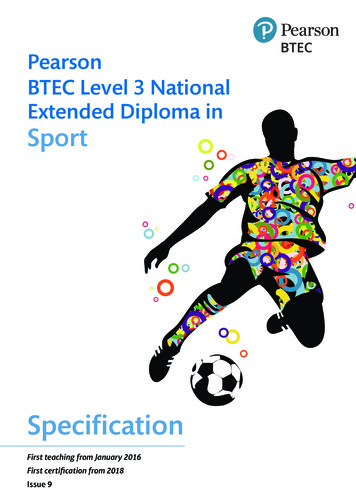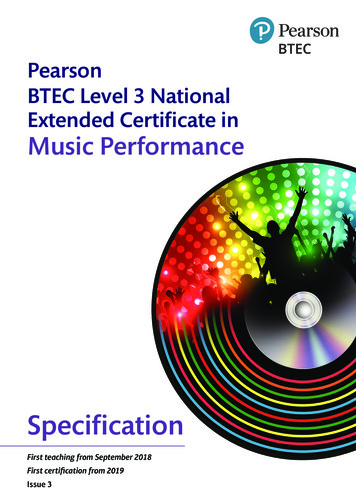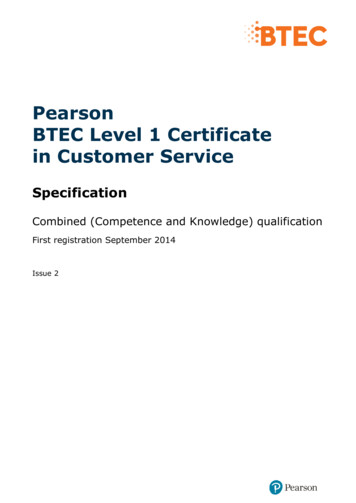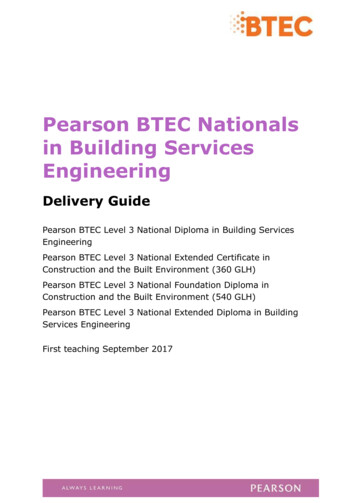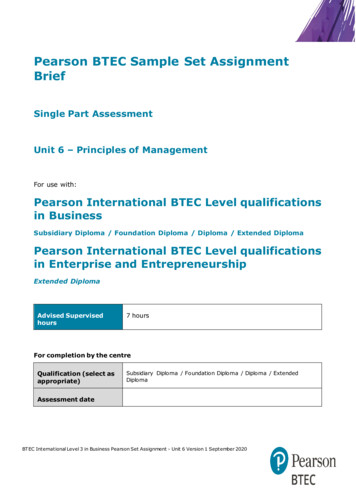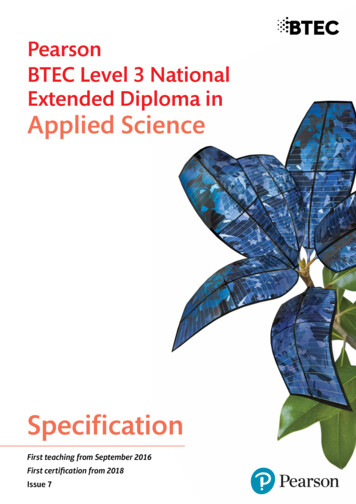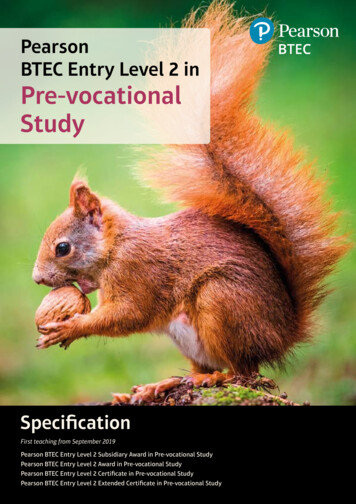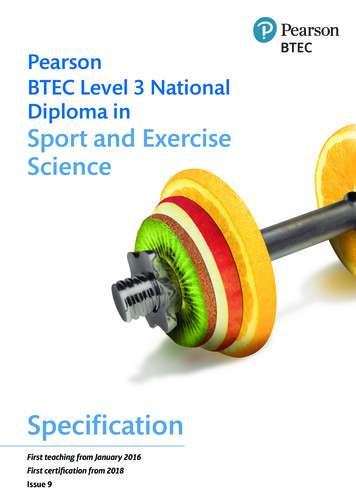
Transcription
PearsonBTEC Level 3 NationalDiploma inSport and ExerciseScienceSpecificationFirst teaching from January 2016First certification from 2018Issue 9
PearsonBTEC Level 3 NationalDiploma in Sport andExercise ScienceSpecificationFirst teaching September 2016Issue 9
Edexcel, BTEC and LCCI qualificationsEdexcel, BTEC and LCCI qualifications are awarded by Pearson, the UK’s largest awarding bodyoffering academic and vocational qualifications that are globally recognised and benchmarked.For further information, please visit our qualifications website at qualifications.pearson.com.Alternatively, you can get in touch with us using the details on our contact us page atqualifications.pearson.com/contactusAbout PearsonPearson is the world's leading learning company, with 25,000 employees in more than 70 countriesworking to help people of all ages to make measurable progress in their lives through learning.We put the learner at the centre of everything we do, because wherever learning flourishes, so dopeople. Find out more about how we can help you and your learners at qualifications.pearson.comThis specification is Issue 9. We will inform centres of any changes to this issue. The latest issuecan be found on our website.References to third-party material made in this specification are made in good faith. We do notendorse, approve or accept responsibility for the content of materials, which may be subject tochange, or any opinions expressed therein. (Material may include textbooks, journals, magazinesand other publications and websites.)ISBN 978 1 446 95552 9All the material in this publication is copyright Pearson Education Limited 2021
WelcomeWith a track record built over 30 years of learner success, BTEC Nationals are widely recognisedby industry and higher education as the signature vocational qualification at Level 3. They provideprogression to the workplace either directly or via study at a higher level. Proof comes fromYouGov research, which shows that 62% of large companies have recruited employees with BTECqualifications. What’s more, well over 100,000 BTEC students apply to UK universities every yearand their BTEC Nationals are accepted by over 150 UK universities and higher education institutesfor relevant degree programmes either on their own or in combination with A Levels.Why are BTECs so successful?BTECs embody a fundamentally learner-centred approach to the curriculum, with a flexible,unit-based structure and knowledge applied in project-based assessments. They focus on theholistic development of the practical, interpersonal and thinking skills required to be able tosucceed in employment and higher education.When creating the BTEC Nationals in this suite, we worked with many employers, higher educationproviders, colleges and schools to ensure that their needs are met. Employers are looking forrecruits with a thorough grounding in the latest industry requirements and work-ready skills suchas teamwork. Higher education needs students who have experience of research, extended writingand meeting deadlines.We have addressed these requirements with: a range of BTEC sizes, each with a clear purpose, so there is something to suit eachlearner’s choice of study programme and progression plans refreshed content that is closely aligned with employers’ and higher education needs for askilled future workforce assessments and projects chosen to help learners progress to the next stage. This meanssome are set by you to meet local needs, while others are set and marked by Pearsonso that there is a core of skills and understanding that is common to all learners. Forexample, a written test can be used to check that learners are confident in using technicalknowledge to carry out a certain job.We are providing a wealth of support, both resources and people, to ensure that learners and theirteachers have the best possible experience during their course. See Section 10 for details of thesupport we offer.A word to learnersToday’s BTEC Nationals are demanding, as you would expect of the most respected applied learningqualification in the UK. You will have to choose and complete a range of units, be organised, takesome assessments that we will set and mark, and keep a portfolio of your assignments. But youcan feel proud to achieve a BTEC because, whatever your plans in life – whether you decide tostudy further, go on to work or an apprenticeship, or set up your own business – your BTECNational will be your passport to success in the next stage of your life.Good luck, and we hope you enjoy your course.
Collaborative developmentStudents completing their BTEC Nationals in Sport and Exercise Science will be aiming to go on toemployment, often via the stepping stone of higher education. It was, therefore, essential thatwe developed these qualifications in close collaboration with experts from professional bodies,businesses and universities, and with the providers who will be delivering the qualifications.To ensure that the content meets providers’ needs and provides high-quality preparation forprogression, we engaged experts. We are very grateful to all the university and further educationlecturers, teachers, employers, professional body representatives and other individuals who havegenerously shared their time and expertise to help us develop these new qualifications.In addition, universities, professional bodies and businesses have provided letters of supportconfirming that these qualifications meet their entry requirements. These letters can be viewedon our website.Summary of Pearson BTEC Level 3 National Diploma in Sport andExercise Science specification Issue 9 changesSummary of changes made between the previous issue and thiscurrent issuePagenumberThe last paragraph of the Qualification and unit content section has been amendedto allow centres delivering the qualification above to alter the content to reflect thecontext of the country where it is being delivered.Page 5If you need further information on these changes or what they mean, contact us via our website s.html.
ContentsIntroduction to BTEC National qualifications for the sport and exercisescience sector1Total Qualification Time2Qualifications, sizes and purposes at a glance3Structures of the qualifications at a glance4Qualification and unit content5Assessment5Grading for units and qualifications7UCAS Tariff points71 Qualification purpose82 Structure113 Units13Understanding your units13Index of units174 Planning your programme1475 Assessment structure and external assessment149Introduction149Internal assessment149External assessment1496 Internal assessment151Principles of internal assessment151Setting effective assignments153Making valid assessment decisions155Planning and record keeping1577 Administrative arrangements158Introduction158Learner registration and entry158Access to assessment158Administrative arrangements for internal assessment159Administrative arrangements for external assessment160Dealing with malpractice in assessment162Certification and results164Additional documents to support centre administration1648 Quality assurance1659 Understanding the qualification grade16610 Resources and support171Support for setting up your course and preparing to teach171Support for teaching and learning172Support for assessment172Training and support from Pearson173Appendix 1 Links to industry standards175Appendix 2 Glossary of terms used for internally-assessed units176
Introduction to BTEC National qualificationsfor the sport and exercise science sectorThis specification contains the information you need to deliver the Pearson BTEC Level 3 NationalDiploma in Sport and Exercise Science. The specification signposts you to additional handbooks andpolicies. It includes all the units for this qualification.This qualification is part of the suite of Sport and Exercise Science qualifications offered by Pearson.In the suite there are qualifications that focus on different progression routes, allowing learners tochoose the one best suited to their aspirations.All qualifications in the suite share some common units and assessments, allowing learners someflexibility in moving between sizes. The qualification titles are given below.Some BTEC National qualifications provide a broad introduction that gives learners transferableknowledge and skills. These qualifications are for post-16 learners who want to continue theireducation through applied learning. The qualifications prepare learners for a range of highereducation courses and job roles related to a particular sector. They provide progression either bymeeting entry requirements in their own right or by being accepted alongside other qualificationsat the same level and adding value to them.In the sport and exercise science sector these qualifications are:Pearson BTEC Level 3 National Extended Certificate in Sport and Exercise Science (603/0444/3)Pearson BTEC Level 3 National Foundation Diploma in Sport and Exercise Science (603/0443/1)Pearson BTEC Level 3 National Diploma in Sport and Exercise Science (601/7421/3)Pearson BTEC Level 3 National Extended Diploma in Sport and Exercise Science (601/7422/5).This specification signposts all the other essential documents and support that you need as acentre in order to deliver, assess and administer the qualification, including the staff developmentrequired. A summary of all essential documents is given in Section 7. Information on how we cansupport you with this qualification is given in Section 10.The information in this specification is correct at the time of publication.Pearson BTEC Level 3 National Diploma in Sport and Exercise Science –Specification – Issue 9 – April 2021 Pearson Education Limited 20211
Total Qualification TimeFor all regulated qualifications, Pearson specifies a total number of hours that it is estimatedlearners will require to complete and show achievement for the qualification: this is the TotalQualification Time (TQT). Within TQT, Pearson identifies the number of Guided Learning Hours(GLH) that we estimate a centre delivering the qualification might provide. Guided learning meansactivities, such as lessons, tutorials, online instruction, supervised study and giving feedback onperformance, that directly involve teachers and assessors in teaching, supervising and invigilatinglearners. Guided learning includes the time required for learners to complete external assessmentunder examination or supervised conditions.In addition to guided learning, other required learning directed by teachers or assessors will includeprivate study, preparation for assessment and undertaking assessment when not undersupervision, such as preparatory reading, revision and independent research.BTEC Nationals have been designed around the number of hours of guided learning expected. Eachunit in the qualification has a GLH value of 60, 90 or 120. There is then a total GLH value for thequalification.Each qualification has a TQT value. This may vary within sectors and across the suite depending onthe nature of the units in each qualification and the expected time for other required learning.The following table shows all the qualifications in this sector and their GLH and TQT values.2Pearson BTEC Level 3 National Diploma in Sport and Exercise Science –Specification – Issue 9 – April 2021 Pearson Education Limited 2021
Qualifications, sizes and purposes at a glanceTitleSize and structureSummary purposePearson BTEC Level 3National ExtendedCertificate in Sport andExercise Science360 GLH (480 TQT)A broad basis of study for the sport andexercise science sector.Equivalent in size to oneA Level.4 units of which 3 aremandatory and 2 areexternal.Mandatory content (83%).External assessment(58%).Pearson BTEC Level 3National FoundationDiploma in Sport andExercise Science510 GLH (680 TQT)Pearson BTEC Level 3National Diploma inSport and ExerciseScience720 GLH (960 TQT)Pearson BTEC Level 3National ExtendedDiploma in Sport andExercise Science1080 GLH (1420 TQT)Equivalent in size to 1.5A Levels.6 units of which 4 aremandatory and 2 areexternal.Mandatory content (76%).External assessment(41%).Equivalent in size to twoA Levels.8 units of which 6 aremandatory and 3 areexternal.Mandatory content (83%).External assessment(46%).Equivalent in size to threeA Levels.13 units of which 7 aremandatory and 4 areexternal.Mandatory content (67%).External assessment(42%).Pearson BTEC Level 3 National Diploma in Sport and Exercise Science –Specification – Issue 9 – April 2021 Pearson Education Limited 2021Designed to support progression tohigher education when taken as part ofa programme of study that includesother appropriate BTEC Nationals orA Levels.Designed as a one-year, full-timecourse covering the fundamentals in thesport and exercise science sector,supporting progression to anapprenticeship in the sports sector or toa further year of study at Level 3.It supports progression to highereducation when taken as part of aprogramme of study that includes otherBTEC Nationals or A Levels.Taken alongside a further qualificationrelated to their chosen field, e.g.A Level Biology, Mathematics orPsychology, or a BTEC Certificate inBusiness, this qualification is forlearners who are intending to studytowards a degree in the sport andexercise sector.This is the largest qualification in thesuite of BTEC Nationals in Sport andExercise Science and is equivalent insize to three A Levels. It is best suitedto learners who want to progress tohigher education programmes in thesport and exercise science sector.3
Structures of the qualifications at a glanceThis table shows all the units and the qualifications to which they contribute. The full structure for this Pearson BTEC Level 3 National in Sport andExercise Science is shown in Section 2. You must refer to the full structure to select units and plan your programme.KeyUnit assessed externallyMUnit (number and title)Mandatory unitsOOptional iplomaExtendedDiploma(GLH)(360 GLH)(510 GLH)(720 GLH)(1080 GLH)MM1Sport and Exercise Physiology2Functional Anatomy3Applied Sport and Exercise Psychology4Field and Laboratory-based Fitness Testing905Applied Research Methods in Sport and ExerciseScience906Coaching for Performance and Fitness907Biomechanics in Sport and Exercise d Fitness Training60OOOOResearch Project in Sport and Exercise Science60OOOOOO10 Physical Activity for Individual and Group-basedExercise6011 Sports Massage60OOO12 Sociocultural Issues in Sport and Exercise60OOO13 Nutrition for Sport and Exercise PerformanceO120M14 Technology in Sport and Exercise Science60O15 Sports Injury and Assessment60O4Pearson BTEC Level 3 National Diploma in Sport and Exercise Science –Specification – Issue 9 – April 2021 Pearson Education Limited 2021
Qualification and unit contentPearson has developed the content of the new BTEC Nationals in collaboration with employers andrepresentatives from higher education and relevant professional bodies. In this way, we haveensured that content is up to date and that it includes the knowledge, understanding, skills andattributes required in the sector.Each qualification in the suite has its own purpose. The mandatory and optional content provides abalance of breadth and depth, while retaining a degree of choice for individual learners to studycontent relevant to their own interests and progression choices. Also, the content may be appliedduring delivery in a way that is relevant to local employment needs.The proportion of mandatory content ensures that all learners are following a coherent programmeof study and acquiring the knowledge, understanding and skills that will be recognised and valued.Learners are expected to show achievement across mandatory units as detailed in Section 2.BTEC Nationals have always required applied learning that brings together knowledge andunderstanding (the cognitive domain) with practical and technical skills (the psychomotor domain).This is achieved through learners performing vocational tasks that encourage the development ofappropriate vocational behaviours (the affective domain) and transferable skills. Transferable skillsare those such as communication, teamwork, research and analysis, which are valued in bothhigher education and the workplace.Our approach provides rigour and balance, and promotes the ability to apply learning immediatelyin new contexts. Further details can be found in Section 2.Centres should ensure that delivery of content is kept up to date. Some of the units withinthe specification may contain references to legislation, policies, regulations and organisations,which may not be applicable in the country you deliver this qualification in (if teaching outside ofEngland), or which may have gone out-of-date during the lifespan of the specification. In theseinstances, it is possible to substitute such references with ones that are current and applicablein the country you deliver subject to confirmation by your Standards Verifier.AssessmentAssessment is specifically designed to fit the purpose and objective of the qualification. It includesa range of assessment types and styles suited to vocational qualifications in the sector. There arethree main forms of assessment that you need to be aware of: external, internal and synoptic.Externally-assessed unitsEach external assessment for a BTEC National is linked to a specific unit. All of the units developedfor external assessment are of 90 or 120 GLH to allow learners to demonstrate breadth and depthof achievement. Each assessment is taken under specified conditions, then marked by Pearson anda grade awarded. Learners are permitted to resit external assessments during their programme.You should refer to our website for current policy information on permitted retakes.The styles of external assessment used for qualifications in the Sport and Exercise Sciencesuite are: examinations – all learners take the same assessment at the same time, normally with awritten outcome set tasks – learners take the assessment during a defined window and demonstrateunderstanding through completion of a vocational task.Some external assessments include a period of preparation using set information. Externalassessments are available once or twice a year. For detailed information on the externalassessments please see the table in Section 2. For further information on preparing forexternal assessment see Section 5.Pearson BTEC Level 3 National Diploma in Sport and Exercise Science –Specification – Issue 9 – April 2021 Pearson Education Limited 20215
Internally-assessed unitsMost units in the sector are internally assessed and subject to external standards verification. Thismeans that you set and assess the assignments that provide the final summative assessment ofeach unit, using the examples and support that Pearson provides. Before you assess you will needto become an approved centre, if you are not one already. You will need to prepare to assess usingthe guidance in Section 6.In line with the requirements and guidance for internal assessment, you select the mostappropriate assessment styles according to the learning set out in the unit. This ensures thatlearners are assessed using a variety of styles to help them develop a broad range of transferableskills. Learners could be given opportunities to: write up the findings of their own researchuse case studies to explore complex or unfamiliar situationscarry out projects for which they have choice over the direction and outcomesdemonstrate practical and technical skills.You will make grading decisions based on the requirements and supporting guidance given in theunits. Learners may not make repeated submissions of assignment evidence. For furtherinformation see Section 6.Synoptic assessmentSynoptic assessment requires learners to demonstrate that they can identify and use effectively,in an integrated way, an appropriate selection of skills, techniques, concepts, theories andknowledge from across the whole sector as relevant to a key task. BTEC learning has alwaysencouraged learners to apply their learning in realistic contexts using scenarios and realisticactivities that will permit learners to draw on and apply their learning. For these qualificationswe have formally identified units which contain a synoptic assessment task. Synoptic assessmentmust take place after the teaching and learning of other mandatory units in order for learners to beable to draw from the full range of content. The synoptic assessment gives learners an opportunityto independently select and apply learning from across their programmes in the completion of avocational task. Synoptic tasks may be in internally or externally assessed units. The particular unitthat contains the synoptic tasks for this qualification is shown in the structure in Section 2.Language of assessmentAssessment of the internal and external units for these qualifications will be available in English.All learner work must be in English. A learner taking the qualifications may be assessed in Britishor Irish Sign Language where it is permitted for the purpose of reasonable adjustment.For information on reasonable adjustments see Section 7.6Pearson BTEC Level 3 National Diploma in Sport and Exercise Science –Specification – Issue 9 – April 2021 Pearson Education Limited 2021
Grading for units and qualificationsAchievement in the qualification requires a demonstration of depth of study in each unit, assuredacquisition of a range of practical skills required for employment or progression to higher education,and successful development of transferable skills. Learners achieving a qualification will haveachieved across mandatory units, including external and synoptic assessment.Units are assessed using a grading scale of Distinction (D), Merit (M), Pass (P), Near Pass (N) andUnclassified (U). The grade of Near Pass is used for externally-assessed units only. All mandatoryand optional units contribute proportionately to the overall qualification grade, for example a unit of120 GLH will contribute double that of a 60 GLH unit.Qualifications in the suite are graded using a scale of P to D*, or PP to D*D*, or PPP to D*D*D*.Please see Section 9 for more details. The relationship between qualification grading scales and unitgrades will be subject to regular review as part of Pearson’s standards monitoring processes on thebasis of learner performance and in consultation with key users of the qualification.UCAS Tariff pointsThe BTEC Nationals attract UCAS points. Please go to the UCAS website for full details of thepoints allocated.Pearson BTEC Level 3 National Diploma in Sport and Exercise Science –Specification – Issue 9 – April 2021 Pearson Education Limited 20217
1 Qualification purposePearson BTEC Level 3 National Diploma in Sport and Exercise ScienceIn this section you will find information on the purpose of this qualification and how its designmeets that purpose through the qualification objective and structure. We publish a full ‘Statementof Purpose’ for each qualification on our website. These statements are designed to guide you andpotential learners to make the most appropriate choice about the size of qualification suitable atrecruitment.Who is this qualification for?The Pearson BTEC National Diploma in Sport and Exercise Science is intended to be an AppliedGeneral qualification. It is for post-16 learners who want to continue their education throughapplied learning, and who aim to progress to higher education and ultimately to employment,possibly in the sport and exercise science sector. The qualification is equivalent in size to two ALevels, and it has been designed as a full two-year programme of study, normally alongside afurther Level 3 qualification.Learners who wish to take this qualification will have successfully completed a Level 2 programmeof study with GCSEs or vocational qualifications.What does this qualification cover?The content of this qualification has been developed in consultation with academics to ensure that itsupports progression to higher education. Employers and professional bodies have also beeninvolved and consulted to confirm that the content is appropriate and consistent with currentpractice for learners who may choose to enter employment directly in the sport and exercisescience sector.The qualification gives learners the knowledge, understanding and skills that underpin the sport andexercise science sector to prepare them for further study or training at a higher level. This includesthe opportunity for learners to choose two units from a selection of options which reflect key topicsin sport and exercise science.Learners will study six mandatory content areas: Applied Research Methods in Sport and Exercise ScienceApplied Sport and Exercise PsychologyCoaching for Performance and FitnessField and Laboratory-based Fitness TestingFunctional AnatomySport and Exercise Physiology.Optional units have been designed to support progression to a range of sector-related courses inhigher education, and to link with relevant occupational areas.The optional content areas include: 8Biomechanics in Sport and Exercise SciencePhysical Activity for Individual and Group-based ExerciseResearch Project in Sport and Exercise ScienceSociocultural Issues in Sport and ExerciseSpecialised Fitness TrainingSports Massage.Pearson BTEC Level 3 National Diploma in Sport and Exercise Science –Specification – Issue 9 – April 2021 Pearson Education Limited 2021
What could this qualification lead to?This qualification is primarily designed to support progression to employment after further study atuniversity. However, it also supports learners who choose to progress directly to employment, asthe transferable knowledge, understanding and skills will give learners an advantage in applying fora range of entry level roles or ‘school leaver’ industry training programmes and HigherApprenticeships in areas such as sport and fitness training, coaching, and sports performanceresearch. Accompanying subjects that would support learners’ progression to these HigherApprenticeships, could include A Level Mathematics or Biology, BTEC Level 3 Extended Certificate inBusiness.In addition to the sector-specific content, the requirements of the qualification will mean thatlearners develop the transferable and higher order skills which are valued by higher educationproviders and employers. For example, the study of field- and laboratory-based fitness testingrequires learners to carry out laboratory-based sport science tests, and then to analyse and drawconclusions from their findings. This activity requires the application of the higher order skills ofanalysis, evaluation and justification.The qualification is intended to carry UCAS points and is recognised by higher education providersas meeting admission requirements for many relevant sports and sport-related courses, forexample: FdA Sports Science HND Sport and Exercise Sciences.When taken alongside other qualifications in the study programme, learners can progress to highereducation courses, for example: taken alongside an A Level in Sociology, it could lead to a BSc (Hons) in Sport and SocialScience, leading to a sports coaching role taken alongside an A Level in Biology, it could lead to a BSc (Hons) in Sport Rehabilitation,leading to roles as a sports rehabilitator or physiotherapist taken alongside an A Level in Mathematics, it could lead to a BSc (Hons) in Sport, PhysicalEducation and Coaching Sciences, leading to roles such as a physical education teacher.Learners should always check the entry requirements for degree programmes with specific highereducation providers.How does the qualification provide employability skills?In the BTEC National units there are opportunities during the teaching and learning phase to givelearners practice in developing employability skills. Where employability skills are referred to in thisspecification, we are generally referring to skills in the following three main categories: cognitive and problem-solving skills: use critical thinking, approach non-routineproblems applying expert and creative solutions, use systems and technology intrapersonal skills: communicating, working collaboratively, negotiating andinfluencing, self-presentation interpersonal skills: self-management, adaptability and resilience, self-monitoring anddevelopment.There are also specific requirements in some units for assessment of these skills where relevant,for example, where learners are required to undertake real or simulated activities.Pearson BTEC Level 3 National Diploma in Sport and Exercise Science –Specification – Issue 9 – April 2021 Pearson Education Limited 20219
How does the qualification provide transferable knowledge and skills forhigher education?All BTEC Nationals provide transferable knowledge and skills that prepare learners for progressionto university. The transferable skills that universities value include: the ability to learn independently the ability to research actively and methodically being able to give presentations and being active group members.BTEC learners can also benefit from opportunities for deep learning where they are able to makeconnections among units and select areas of interest for detailed study. BTEC Nationals provide avocational context in which learners can develop the knowledge and skills required for particulardegree courses, including: 10reading technical textseffective writinganalytical skillscreative developmentpreparation for assessment methods used in degrees.Pearson BTEC Level 3 National Diploma in Sport and Exercise Science –Specification – Issue 9 – April 2021 Pearson Education Limited 2021
2 StructureQualification structurePearson BTEC Level 3 National Diplom
Welcome With a track record built over 30 years of learner success, BTEC Nationals are widely recognised by industry and higher education as the signature vocational qualification at Level 3 .
